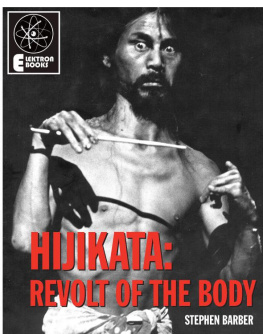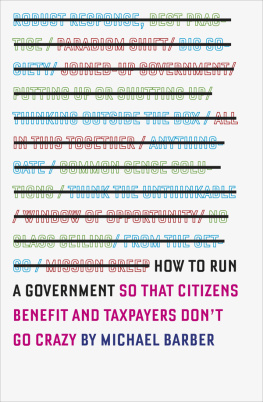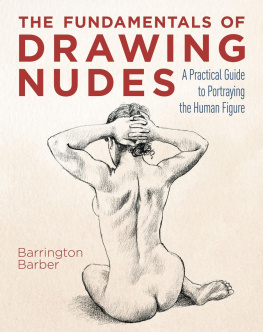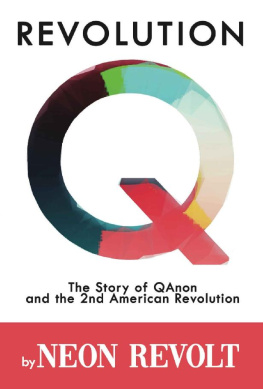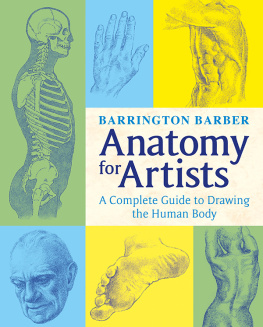Barber - Hijikata: Revolt Of The Body
Here you can read online Barber - Hijikata: Revolt Of The Body full text of the book (entire story) in english for free. Download pdf and epub, get meaning, cover and reviews about this ebook. year: 2013, publisher: SCB Distributors, genre: Non-fiction. Description of the work, (preface) as well as reviews are available. Best literature library LitArk.com created for fans of good reading and offers a wide selection of genres:
Romance novel
Science fiction
Adventure
Detective
Science
History
Home and family
Prose
Art
Politics
Computer
Non-fiction
Religion
Business
Children
Humor
Choose a favorite category and find really read worthwhile books. Enjoy immersion in the world of imagination, feel the emotions of the characters or learn something new for yourself, make an fascinating discovery.
- Book:Hijikata: Revolt Of The Body
- Author:
- Publisher:SCB Distributors
- Genre:
- Year:2013
- Rating:4 / 5
- Favourites:Add to favourites
- Your mark:
- 80
- 1
- 2
- 3
- 4
- 5
Hijikata: Revolt Of The Body: summary, description and annotation
We offer to read an annotation, description, summary or preface (depends on what the author of the book "Hijikata: Revolt Of The Body" wrote himself). If you haven't found the necessary information about the book — write in the comments, we will try to find it.
Hijikata: Revolt Of The Body — read online for free the complete book (whole text) full work
Below is the text of the book, divided by pages. System saving the place of the last page read, allows you to conveniently read the book "Hijikata: Revolt Of The Body" online for free, without having to search again every time where you left off. Put a bookmark, and you can go to the page where you finished reading at any time.
Font size:
Interval:
Bookmark:

credits
HIJIKATA: REVOLT OF THE BODY
BY STEPHEN BARBER
AN EBOOK
ISBN 978-1-908694-61-4
PUBLISHED BY ELEKTRON EBOOKS
COPYRIGHT 2012 ELEKTRON EBOOKS
www.elektron-ebooks.com
No part of this publication may be reproduced, stored in a database or retrieval system, posted on any internet site, or transmitted, in any form, or by any means, electronic, mechanical, photocopying, recording or otherwise, without the prior permission of the copyright holders. Any such copyright infringement of this publication may result in civil prosecution
Acknowledgements
Id like to thank everyone in Tokyo who spoke to me about Tatsumi Hijikata:
Akiko Motofuji, Gala Motofuji, Donald Richie, Eikoh Hosoe, Takahiko Iimura, Kazuo Ohno, Yoshito Ohno, Min Tanaka, Ko Murobushi, Kim Itoh, Shinjin Shimizu, Adam Broinowski, Hironobu Oikawa, Kuniichi Uno, Tatsuro Ishii, Kazuko Kuniyoshi, Nario Goda, Tadashi Uchino, Midori Matsui, and Kazue Kobata. Id also like to thank Hillary Raphael, and Katharina Belting of the Japan Society in New York, Mark Holborn, and Marie-Gabrielle Rotie of the Butoh UK organization in London.
Id especially like to thank the curators of the Tatsumi Hijikata Archive at the Keio Universitys Research Centre for the Arts in Tokyo: Takashi Morishita and Takemi Murai, and also its director, Yoichi Sumi; also, the curator of the Kazuo Ohno Archive at Bologna University, Elena Cervellati.
Im grateful for the grants I received for this book from the Daiwa Anglo-Japanese Foundation, the Japan Foundation Endowment Committee, the London Arts Board, and the Saison Foundation in Tokyo.
INTRODUCTION
ANKOKU BUTOH AND HIJIKATA'S DEATH
The first movement is death. The human body can barely be seen, and has always eluded being written about. It is an infinite mystery that creates its own language, lost at the periphery of vision, while simultaneously grating its movements together from raw flesh. When the gestures of the body are torn and fragmented to the extreme, another body emerges, interrogative of ecstasy, collapse, and human obliteration. And its movements transform or annul the eye, as they transform and annul the body itself. To write about such movements is an act of wilfulness. Tatsumi Hijikata wrote and spoke about these movements, while spending an entire lifetime anatomising them, and called them the projections of Ankoku Butoh: the dance of utter blackness, or, simply, dark dance.
Hijikata is the supreme figure in the second half of Japans twentieth century experimental culture, and the most seminal and inspirational figure of that previous century for innovative artists, choreographers, film-makers, musicians and writers working in contemporary Japan. At the moment when Hijikata began his work, the history of Japan had ended: the human body had been consumed into ashes at the close of the first half of the twentieth century, and that history then rebuilt itself as though nothing had happened, when everything had changed. And Japan had been torn open, as never before, to the vast rush of imageries, influences and obsessions from outside itself: to Europe, and especially to the USA. Hijikatas thirty-year-project of intensive reformulation of the human body took place precariously, as a stamping on the cracked surface over a void; it took place in Tokyo, during the decades in which the destroyed city escalated from a swathe of horizontal debris to an immense megalopolis of vertical towers, unprecedentedly wealthy, but simultaneously coursed by fracture-lines of riots and violent unrest, generated by its upheavals. Hijikata never left Japan, and rarely even left Tokyo, from the time of his arrival there in 1952, until his death in 1986; for over a decade before he died, he had refused to perform, and had stayed-put in his studio in the Tokyo district of Meguro, negating movement itself until it focused down to his own, endlessly prefigured and imagined death. Inversely, the international impact and repercussions of his Ankoku Butoh performance art expanded as his own bodys movements diminished; during the final years of Hijikatas life, and then in the subsequent decades, Ankoku Butoh increasingly seized the attention of artists working worldwide, setting off virulent sequences of imageries, languages and corporeal transformations, extending far from the domain of choreography, into digital art, music, and performance. But such movements remained always bound in enthralment with the moment between creativity and death.
Hijikatas own death came from comprehensive liver failure, after a decade of concentrated whisky-drinking, on a ward of the Tokyo Womens Medical College Hospital, on 21 January 1986, at the age of fifty-seven. His death had not been sudden; he had been working in his studio until the previous month, and then his body collapsed, leaving him with several immobilised weeks in his hospital bed, moving in and out of consciousness. On the final day, his friends assembled at his bedside, and helped him to sit upright.
Then, he performed his final act of Ankoku Butoh. One witness remembered Hijikata on the point of death: This gesture arose from his hazy semi-consciousness: he assembled the fingers of both hands and formed the outline of a ball of paper within the empty space between those fingers, rolled the ball on his chest and then wedged it delicately under his cheek. Another friend remembered the characteristic final hand-gestures of a dying alcoholic scrabbling blindly at the blankets covering the chest being suddenly transformed by Hijikata in the last moments of his life into an infinitely nuanced set of choreographed gestures, sending human bodies into intricate contortions with those fingers.
In the year before his death, Hijikata had spoken of one of his ambitions for what the performance acts of Ankoku Butoh would reveal to their audiences: I would like to have a person, who has already died, die over and over inside my body I may not know death, but it knows me.(1) Before Hijikatas body was cremated, one of his friends, the photographer Eikoh Hosoe, recorded an image of Hijikata in his coffin, surrounded by bunches of flowers; a photograph placed alongside the coffin showed his face vividly in the act of speaking, fifteen or so years earlier, during the period when he had still been active in giving performances. Hijikatas face in death appeared aberrantly tranquil, his mouth open, his waist-long hair combed back from his forehead. A cast was also made of his muscular, dancers foot: the right foot, displaying an ovular, empty space between the big toe and the other toes.
Hijikatas Ankoku Butoh formed a multiple excavation of death. Like his closest collaborator, the dancer Kazuo Ohno, and the European writer he admired most, Jean Genet, Hijikata conceived of his audience as being that of the dead. Not only the living bodies of the spectators were there before him, but also the innumerable presences of the human figures who had already died, but remained attached to the space in which Hijikatas body was emanating the acts or gestures of death. Jean Genet wrote in the 1960s of his desire for his theatrical work to be performed in vast, derelict cemeteries, with the tower of the crematorium chimney looming over the spectacle; the audience would flicker between the ranks of the living and the vaster ranks of the dead. Hijikata saw his performance acts ricochet between his own body and that of the bodies of his audience, who, apparently alive, had been engulfed by a power of death (superficially, that of the full-tilt monstrosity of contemporary, consumerist Japan, but, more profoundly, a power meshed into the vital substance of the corporeal itself), and now demanded to be reactivated and resuscitated, for a moment, at least. While his own body carried death as a latent spectacle to be revealed by gesture that projection always imminent, and a membrane away from exposure the audience too exuded its own death, and as a result of that identicality, it intimately attached itself to the fragments, convolutions and seisms of Hijikatas body.
Next pageFont size:
Interval:
Bookmark:
Similar books «Hijikata: Revolt Of The Body»
Look at similar books to Hijikata: Revolt Of The Body. We have selected literature similar in name and meaning in the hope of providing readers with more options to find new, interesting, not yet read works.
Discussion, reviews of the book Hijikata: Revolt Of The Body and just readers' own opinions. Leave your comments, write what you think about the work, its meaning or the main characters. Specify what exactly you liked and what you didn't like, and why you think so.

